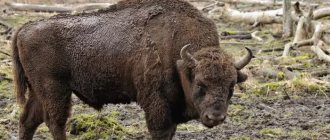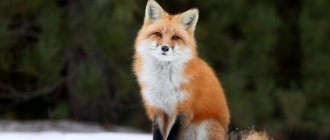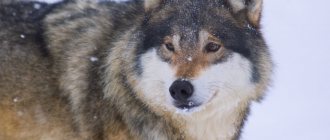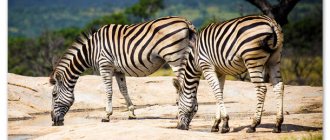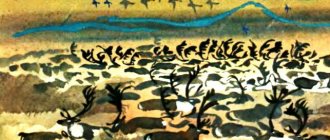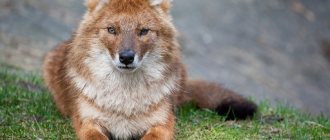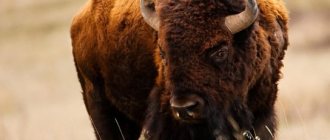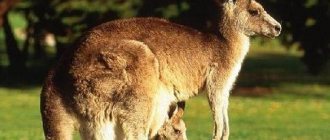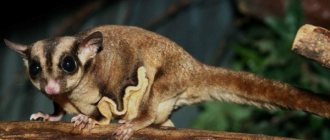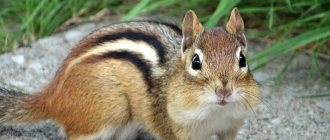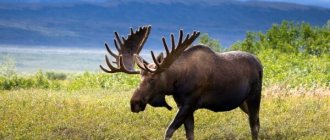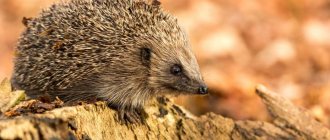- Encyclopedia
- Animals
- Bison
The bison is a large, strong, wild bull, an inhabitant of forests, meadows, near the river. They are usually called the masters of forests, due to their enormous size.
Bison are listed in the Red Book, as their population was almost completely exterminated by poachers. Recently, thanks to the work of specialists in nature reserves and private national parks, the extinction of these animals has been stopped. For example, in the Caucasus State Natural Biosphere Reserve, located in the Krasnodar Territory, there are already more than 400 individuals.
The weight of an adult male can reach 1 ton, height - up to 175-195 cm, length - 250-340 cm. The size of the female is smaller than that of the males.
The bison has a large front part of the body with a hump and a wide chest. The back of its body is narrower and shorter compared to the front. The bison's fur is very thick, longer on the head and neck, which allows it to sleep in the snow without freezing. The horns of this mighty giant are sharp at the ends, curved forward.
Bison live in herds, up to about 15 animals in 1 herd. They live for about 15-25 years, in nature reserves and parks up to 30.
Such a large animal as the bison seems clumsy and good-natured. He avoids meeting people and does not come close. But when angry they are very dangerous. They are not afraid of any obstacles, neither bushes nor small trees. A female protecting her cub is especially dangerous. It is better not to approach her and not to irritate her in any way.
During the day, this animal rests, lies on the grass and basks in the sun. It usually grazes in the mornings and evenings on pastures with lush grass, next to a watering hole. Thanks to its strength and endurance, it can walk up to several tens of kilometers a day without rest, in search of new pastures.
The bison is a herbivorous mammal; other forest inhabitants are not afraid of it. The main enemies of this bull are bears and wolves. These predators mainly attack young calves. Bison protect their offspring from attacks by predators by standing around them, covering them with their powerful bodies.
The daily diet of bison is a large variety of plants, mainly grasses; they also love tree leaves, shrubs, bark, and young trees. In winter, these animals dig up roots, mosses, and lichens in the snow. In a day, such a bull eats about 55 kg of a variety of plant food.
The bison is an animal that has lived on our planet since the times of the ancient world. Our task is to preserve this magnificent and majestic view.
Appearance
The body length can reach up to 330 cm, its weight is up to one ton, and the height at the withers is up to 2 meters. The head is small in relation to the body. The eyes are dark brown, the nose is large, with large nostrils.
Antlers, and there are two of them, grow throughout life and do not change, like, for example, a deer. A hump, a sloping back, a powerful build, strong low legs and a long tail - that’s what a bison is like.
There is a thick beard under the chin. The fur color is chestnut, the sides are brown. The fluffy and soft undercoat keeps the animal's body warm and protects it from getting wet.
The upper hard guard hairs protect the bull from contamination. The sense of smell is well developed, but hearing and vision are slightly worse. Females are smaller in size and weight than males.
The bison is a mighty descendant of the most ancient bulls
Bison are deservedly considered the rulers of the forest due to the amazing power, strength, and greatness of this beast. The history of the animal, dating back to antiquity, amazes with its depth and drama.
The bison were exterminated to a critical minimum, but reserve specialists and private individuals created nurseries in which the last individuals of the population were taken under protection and saved.
Lifestyle
Bulls seem heavy and clumsy, calm and indifferent. In fact, they can quickly chase after a troublemaker, and if necessary, they can butt heads. At the same time, they snort angrily, shake their heads, and their eyes become bloodshot. Neither dense thickets nor a 2-meter high fence are an obstacle.
They go out to graze in the morning and evening; during the day they prefer to rest. Males lead a solitary lifestyle. Several females (2 or 3) form a herd together with their calves. An experienced female leads the herd, everyone obeys her.
Young males live separately in small groups, preparing for adult independent and solitary life. In the fall they molt in preparation for the cold winter, their fur becomes thick and long. Many family groups unite in winter into herds of 20 or more animals. This makes it easier to protect small calves from predators.
Option 2
The bison is a large artiodactyl mammal.
In the mid-20th century, bison almost disappeared from the face of the earth due to poaching. At that time, both the Caucasian subspecies and wild lowland bison were exterminated. At that time, only 12 individuals of the subspecies remained, which were in zoos and nature reserves.
Bison are very heavy and massive in build. Males reach a weight of up to 1000 kg. Females are much smaller and sleeker. The muscles in the front are strong and developed, there is a hump on the back, a small head and a very wide forehead. The back part of the body has underdeveloped muscles and is dry. The color of bison is brownish-brown. There is thick hair on the forehead, a short beard and a small mane.
The average life expectancy of a male bison is 20-22 years, a female – 25-27 years.
Despite its physical strength, the bison is a herbivore. The bison spends a sunny day lazily, chewing cud. And only in the early morning and evening the search for water and food begins. Bison feed on grass, leaves, shrubs and tree lichens.
Bison love to brush their fur with dry earth, slowly rocking and basking in the sun's rays.
Bison constantly roam long distances changing pastures. The gait of bison is heavy, slow at first glance, as if lazy, but this is not so. In case of danger or rage, movements become almost lightning fast, running speed is fast.
Bison are very careful and wary animals. They tend to hide in dense forests.
At the end of summer, bison mating games begin. Males fiercely compete and fight among themselves for the female they have chosen. In battles, they take intimidating poses and make loud noises. There are even fierce fights that end in severe injuries or death.
The female carries the fetus for about 9 months. Once born, babies become independent quite quickly. An hour after birth, they are already running, and after 20 days they switch to a herbivorous diet. The female continues feeding with milk for 5 months.
Bison are a herd animal. The herd consists of females and calves. The most experienced female acts as the leader. Males are solitary by nature. At a young age they stay in a group, and then scatter.
Currently, there are about 3,000 bison in zoos around the world, half as many in the wild. They are actively trying to restore the natural bison population to recreate natural forest areas.
Currently, the bison is listed in the Red Book in the first category - endangered animals. Hunting for it is strictly prohibited.
Reproduction
The mating season begins at the end of July and lasts until September. Males come to the female herd, drive away the young calves, and begin courtship. Fights between bulls are not uncommon; the fights are brutal. The defeated one leaves with nothing, but the hero will have to continue courting the female. Her pregnancy lasts 9 months.
By the time of calving, she goes to a secluded place, where one light beige calf is born, weighing up to 25 kg.
As expected, mom licks him, they exchange information about smells. Having rested, the cub rises to its feet and drinks its mother’s fatty milk. After 1 - 1.5 hours it can follow her. They will return to the herd in a few days. Everyone will become familiar with the new member of the group, but the calf will clearly know by smell where its mother is.
It will try its first plant food at the age of three weeks. He will feed on his mother's milk for up to a year. Little calves play with each other, repeat and copy the movements of adults. For them, this is important information and skills to live in a beautiful, wild, but not simple world. In a herd, calves live up to three years.
Features and habitat of the bison
The bison is the largest representative of terrestrial mammals in Europe, a descendant of wild bulls. In the Middle Ages, forest giants were common in forest areas from east to west throughout Eurasia.
What kind of animal the bison is can be understood from its size:
- The weight of a modern adult bison reaches 1 ton. The ancestors were even larger, up to 1200 kg;
- the height of the animal at the withers reaches 180-188 cm;
- length – up to 270-330 cm.
Females are slightly smaller. The bison has a massive front part of the body with a large hump that combines a short neck and back. The back of the body is compressed and smaller in size.
The chest is wide. The tail, covered with hair, up to 80 cm long, ends in a brush-like tuft of hair. Strong and sturdy legs with convex hooves, the front ones are much shorter than the rear ones.
The bison is the largest representative of land mammals
The head with a wide forehead is very low, even the tail of the animal is higher than the crown of the head. The black horns are spread out and pushed forward. Their surface is smooth, their shape is hollow and round.
The length is up to 65 cm, and the spread of the horns is up to 75 cm. The name of the animal possibly goes back to the Proto-Slavic word “tooth,” meaning a sharp object. The giant's horns, pointed and directed forward, determined his name.
The ears are small, hidden in the hair on the head. Eyes with bulging black eyeballs, large and thick eyelashes. The mouth part is blue. The bison's sense of smell and hearing are well developed, but its vision is slightly worse.
The fur is dark brown, with a reddish tint in young individuals. Short, dense and waterproof, protects the animal from dampness and cold. The neck and hump are covered with longer hair. You can even notice a small bison beard.
Mighty bulls live in herds, which include cows and young animals. Sexually mature bison join their relatives during mating time. One herd can contain from 10 to 20 animals.
An animal similar to a bison is the American bison. The differences between them are small. There is a common offspring of these relatives - bison.
In the 1920s, bison disappeared from the wild. Today, the bison is an animal from the Red Book; modern powerful forest inhabitants originated from rescued individuals in special nurseries and reserves. Only 30 years later did the settlement of the first herd bison become possible.
Two types of bison are recognized:
- Belovezhsky (plain), larger, with long legs. Lived in England, Scandinavia, Western Siberia;
- Caucasian (mountain), lived in the Caucasus. It was distinguished by its smaller size and curly hair. It was destroyed at the beginning of the 20th century.
Bison live in mixed coniferous and deciduous forests, with open glades, not far from the river. Currently, bison can be found in Russia, Poland, Moldova, Belarus, Latvia, and Kyrgyzstan.
Nutrition
The diet of herbivorous bison is based on several hundred plant species. The diet consists of leaves, shoots, tree bark, branches of shrubs, some herbs, and lichens.
The nutritional value of feed depends on the season. In summer they like maple greens, willow, and ash. In autumn, they additionally eat mushrooms, berries, and acorns. During the cold winter period, animals dig out snow with their hooves in search of food, feed on bark, thin branches of bushes, pine needles, and lichens.
One bull requires up to 50 kg of feed per day. In nature reserves, bison are fed with hay. The bison do not allow anyone near the feeding troughs in the reserves. There are known cases of animals killing moose, horses, and deer—food competitors in nature.
The bison can feed on thin branches and pine needles
Origin of the species and description
Photo: Bison
The bison is the last representative of the wild bull on European territory. In accordance with historical data, animals descended from their ancient ancestors - bison. They represent the bovid family and belong to the ungulate herbivorous mammals.
Historical data indicate that during the Ice Age the bison already existed and was the object of hunting by people of that time. These facts are confirmed by rock paintings of that time discovered by archaeologists. Also, mention of this amazing beast was found in the ancient chronicles of the Egyptians and Romans. It is known for certain that in ancient Rome bison were participants in gladiatorial fights.
Belovezhsky bison in Russia
Since the creation of the Red Book in Russia, the bison has been included there. At the end of the twentieth century, the country adopted the project “Strategy for the Conservation of Bison in Russia.” Breeding of animals of the Belovezhsky species is carried out by nurseries in reserves on the Oka River, from where the young animals are transferred to reserves, game reserves and national parks of Russia.
According to the World Wildlife Fund, there were more than 1,000 lowland bison in Russia in 2022.
More than 400 bison live on the territory of the Oryol Polesie National Park. The park's herds live in the wild, which increases the chances of successful relocation to other regions of Russia.
Rice. 1. Bison in Oryol Polesie.
Where does the bison live?
Photo: Bison Reserve
Bison are relatives of wild bulls. Until the moment of mass extermination, they inhabited a vast territory. They lived in large numbers in the Caucasus, in western, southeastern and central Europe, Iran, and Scandinavia. It is noteworthy that at that moment they were located not only in the forest area, but also in open areas - steppes, valleys. As they were exterminated, representatives of the species moved to increasingly remote and remote areas.
Today, the regions where bison live are forest-steppes and forest areas that are located near water bodies. Today, their main habitat is the territory of Belovezhskaya Pushcha.
We found out where the bison lives, now let's figure out what it eats.
Interesting Facts
There are several interesting facts about bison; information about them and a detailed description of their lifestyle are provided by zoologists and reserve managers. Archaeologists in the last century discovered the remains of bison and examined them. It turned out that the ancient descendants of bulls were mammoths.
The first description of the animal was made by Aristotle in the fourth century BC. Although bison look clumsy, when angry they can jump over fences up to two meters high. Females and bulls have a big difference in life expectancy - ten years in favor of the former.
Belovezhskaya Pushcha is the largest reserve with bison. It is located on the territory of two countries at once - Poland and Belarus. And in 1923, biologists conducted the first census of animals in nurseries and zoos, and also divided them into classes by age and habitat.
Poland publishes new stud books every year indicating the number of bulls in each country. Some North American tribes believe that the birth of a calf with white fur will bring prosperity to the area where it appears. Bison are the only animals that have been returned to the wild after being completely exterminated by poachers. It is also known that not a single bull has been domesticated.
Bison in the Caucasus
All modern Caucasian bison have one purebred ancestor - a bison named Caucasus, who died at the beginning of the twentieth century. Calves from lowland females and the Caucasus made it possible to revive the destroyed species. Subsequently, the animals crossed with American bison, and the new species was named bison.
Bison easily adapted to free life in the Caucasus mountains and migrated from the foothills to high-mountain meadows.
Currently, the Caucasian Nature Reserve is engaged in the protection and breeding of bison, where in 2022 there were more than 1,100 bison. Genetic analysis showed that the proportion of bison admixture has decreased to 5%, the appearance corresponds to the Caucasian bison.
Rice. 2. Bison in the Caucasus in winter.
In the Prioksko-Terrasny Nature Reserve, a group of American steppe bison is kept in an enclosure. They are not released into the wild because they easily interbreed with bison.
Bison mating games
Each adult bison lives alone. Towards the end of the summer season, the male chooses a female from a group of animals. Next, the giant protects the chosen herd from any dangers and invasion, thereby trying to win the trust and respect of the chosen one. Sometimes several bison compete for a group of females, and then competitions can occur—fights that determine the winner. This is a kind of presentation that helps to gain authority among females. At the same time, bison make terrifying sounds.
The female carries the fetus for 9 months. Immediately after birth, the baby gets acquainted with the world around him and within an hour runs after his mother. Within 20 days, the newborn learns to feed on its own, but the female feeds him milk for up to five months.
Bison's brother
In terms of morphological and genetic characteristics, bison are close to bison; they interbreed freely and produce fertile offspring in any combination. The genetic similarity of bison and bison has been confirmed by the latest research, but they are geographically isolated, and despite the absence of significant morphological, ecological and adaptive differences, bison and bison are classified as close but independent species.
Photo: Anton Agarkov / WWF Russia
general information
Bison, an animal that scientists classify as a member of the bison genus. Based on the identified remains, it was determined that they lived on earth two million years ago. The European and American varieties of the beast that have survived to this day are considered bison. There was also a steppe bison, but its disappearance dates back hundreds of thousands of years.
If we talk about the name of the beast, now listed in the Red Book, then back in the time of Vladimir Monomakh it was called a buffalo, aurochs. The last name was found in the sayings of Julius Caesar, Polish and Russian epics. Today, under this name in the scientific world there is a bull that became extinct in the Stone Age. Perhaps the word bison originates from this name, perhaps from the Russian Orthodox Zǫbrъ - “a beast with sharp horns.”
In free nature, the European bison had two subspecies recognized by science: the plain or lowland bison rude (Bison bonasus bonasus) and the Caucasian mountain bison (Bison bonasus caucasicus). Now only the Belovezhskaya (lowland) line has been preserved in its pure form. The current Caucasian species is a hybrid formation.
The differences are in size and coat. The Caucasian species is slightly smaller, its coat is darker and somewhat curlier.
What does bison eat?
Bison feed on herbaceous and tree-shrub (leaves, shoots, bark) vegetation. Their menu includes no less than 400 types of vegetation and changes with the seasons. In winter, bison often come for artificial feeding from hay, and regularly go to salt licks. Bison graze in the morning and evening, and in hot weather they also go to water twice a day.
